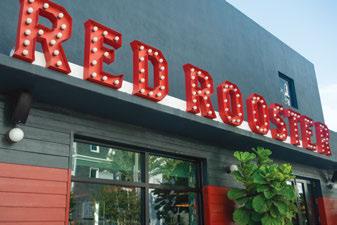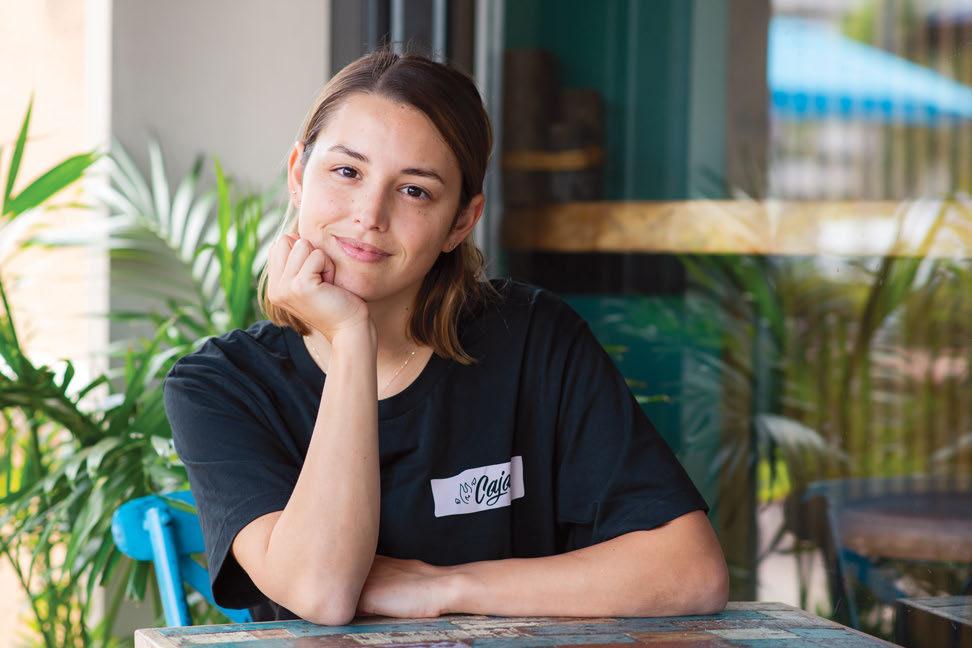
10 minute read
CONCEPT
RUSSO CHRISTINE PHOTO:
Mika Leon
Advertisement
CAJA CALIENTE
Monica “Mika” Leon comes from a family of ever-busy restaurant professionals—her grandfather was a restaurateur in Spain, and her mother owned a catering company. Leon always gravitated toward food and restaurants, but her mom warned against the long hours and stress. Leon went on to study business and PR at the University of Florida but couldn’t keep away from hospitality. In 2011, she started a food blog, Mikabites, and converted her mom’s garage into a wholesale bakery. (Local supermarkets couldn’t get enough of her empanadas.) She bought a food truck in 2016 and named the new enterprise Caja Caliente. Although Leon’s mother thought she was nuts, she immediately jumped in to help make the truck a hit. ey began with Cuban pork tacos and some juices in Wynwood, and the truck’s success led to a brick-and-mortar in Coral Gables in 2019. Leon has since been named an Eater Young Gun semi nalist and competed on Food Network’s Beat Bobby Flay and Guy’s Grocery Games. She’s now working on a line of retail cooking products. At only 30, she’s given Miami a strong appetite for her family recipes, which her mother, uncles, and cousins still prepare together in the Caja Caliente kitchen.
mikabites / cajacaliente
Favorite kitchen tool: My stand-up mixer. I’m an avid baker and nd it really relaxes me, especially in our very stressful industry. Tool you wish you had: I have way too many tools to the point where my guest room is now a storage of cooking equipment, but I don’t have a pizza oven, which I really, really want! Favorite cookbook: My family cookbook. e handwritten messages are the best. Most important kitchen rule: Prep. Always prep and clean as you go. What you eat on your nights o : I cook at home with my boyfriend, and we love baking and making homemade pasta or barbecue. Amazing comfort food and PJ's! Nothing better!
El Lechón
If there’s a secret to Caja Caliente’s success, it would have to be the family recipe for lechón. e pork shoulder lled the rst taco that Mika Leon served out of her food truck, and the menu now features it in seven di erent ways. Her grandfather made a name for his Cuban restaurants in Spain with the crispy, sweet meat, and Leon has done the same. e recipe is top secret, but we can share that Leon marinates it overnight to give it strong avors of garlic, sour orange, and oregano. Depending on the size, it’s baked for four to six hours, deboned, shredded, and weighed into equal portions for consistency, a hallmark of Caja Caliente. “[My grandfather] made it every Christmas Eve,” Leon says. “I ate it on my birthday. I spruced up the traditional tamal that we grew up eating.”
BLUNT WILL PHOTO:
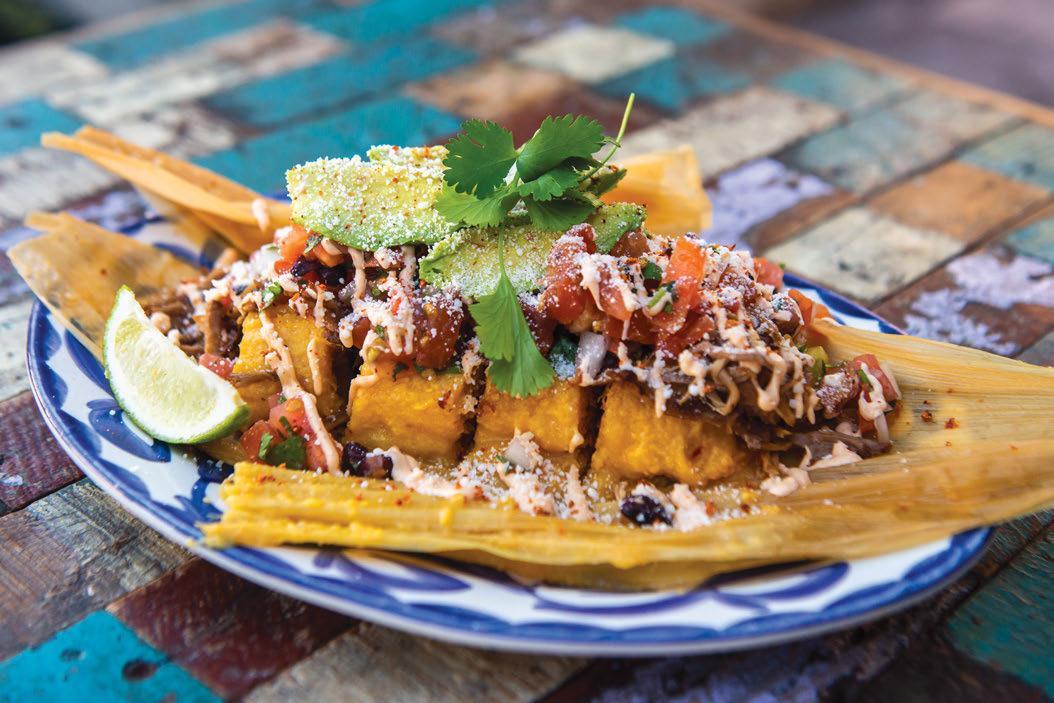
Tamal Cubano
Chef Mika Leon of Caja Caliente Adapted by StarChefs
INGREDIENTS
Tamal:
2 pounds Niman Ranch pork shoulder, cut into small pieces ¼ cup olive oil 1 large red bell pepper, chopped 1 large onion, chopped 3 cloves garlic, chopped 8 ounces tomato sauce 4 cups corn kernels 2 sticks butter 2 cups chicken broth 2 cups cornmeal Salt 30 corn husks (depending on size)
Spicy Aïoli:
2 cups mayonnaise 2 canned chipotle peppers 3 tablespoons adobo sauce from canned chipotles 1 tablespoon ground cumin 2 tablespoons lime juice 1 teaspoon salt
Pico de Gallo:
2 white onions, diced 8 ripe plum tomatoes, diced 2 jalapeños, deseeded and diced 1 can of black beans, drained Salt 2 cups cilantro, chopped Juice of 2 limes 3 tablespoons extra virgin olive oil
To Assemble and Serve:
Avocado, sliced Cotija cheese Niman Ranch pork, crisped up and shredded Fresh Origins micro cilantro
For the Tamal:
In a pot over medium ame, cook pork in a bit of oil until browned and cooked down. Remove pork from pot and set aside. Add remaining olive oil, pepper, onion, and garlic and cook until soft and translucent. Add a few small pieces of cooked-down pork and tomato sauce; stir and let simmer for about 15 to 20 minutes.
Meanwhile, in a food processor, combine corn and butter until a thick paste forms. Add chicken broth and cornmeal and mix. Remove simmering meat mixture from heat and add corn mixture. Stir until fully combined. Season with salt. Let cool. Form tamales in corn husks, rectangular in shape, doublewrapped, and tied with cooking twine. Place them in the freezer for at least a few hours until frozen and rm.
METHOD
For the Spicy Aïoli:
Add all ingredients to a food processor and blend until smooth.
For the Pico de Gallo:
In a large mixing bowl, add onions, tomatoes, jalapeños, and black beans. Season with salt and mix gently. Add cilantro, lime juice, and oil. Mix again and season with salt.
To Assemble and Serve:
In a large pot of boiling water, add Tamales; boil 30 minutes. Remove and discard excess water. Top a tamal with avocado, cotija cheese, Spicy Aïoli, Pico de Gallo, crispy shredded pork, and micro cilantro.
The Overtown of Tomorrow The Overtown Overtown of Tomorrow By Carolyn Guniss
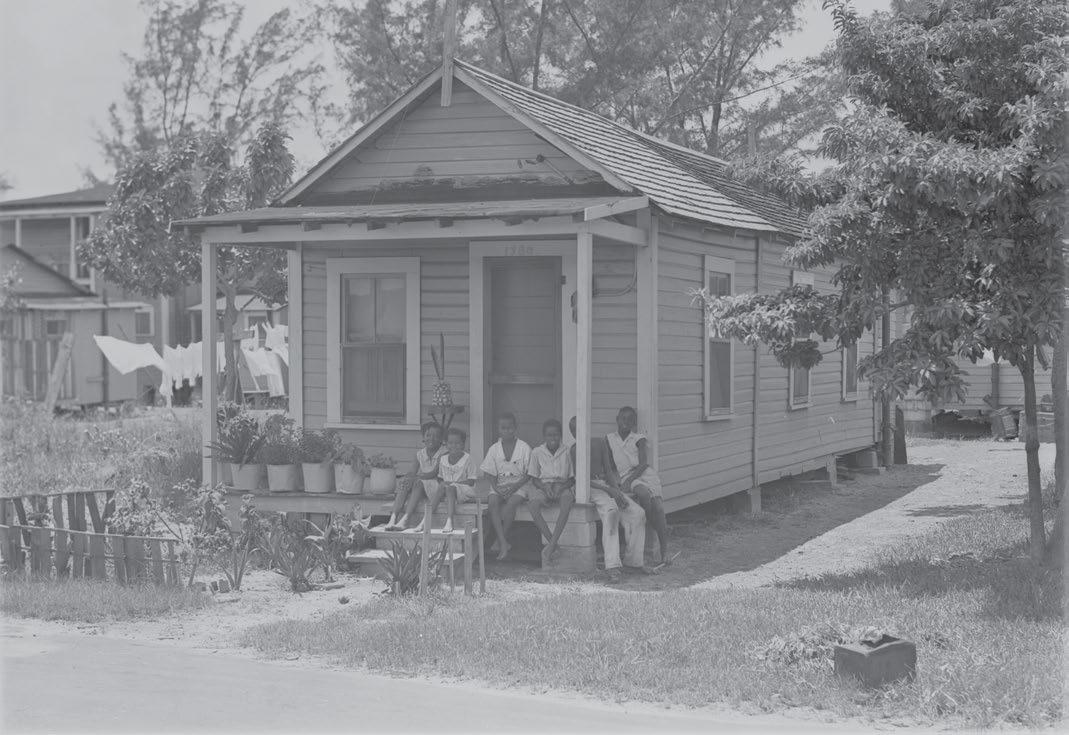
e Miami neighborhood of Overtown has always been intriguing; it can be vexingly dark and the brightest star at the same time. e streets echo the jazz greats of an era gone, when Overtown served as the epicenter of commerce and prosperity of Black Americans in Miami.
But in the 1960s, a mess of concrete and asphalt crashed down in the form of Interstate 95, jutting through Overtown and cutting it o from the progress that completely surrounds it. By 1971, a path for I-395 was also erected in the neighborhood.
At times, the residents’ e orts to succeed were drowned by social ailments—drug epidemics and homeless people living under that interstate—and, less often now, the pop pop of unresolved con icts. Always present, though, is the waft of avor and promise, and that is what has drawn talented chefs and their concepts.
Overtown personi es the resilience of a people who seek opportunity and restoration. e removal of the implanted highway started about a year ago, and an $818 million state transportation project will reconnect Overtown to nearby Downtown Miami and Miami Beach. Expected to be completed in 2024, a signature bridge will span 1,025
feet through Miami’s skyline, linking a double-decker SR 836 to an expanded I-95 and a widened I-395, which could give Overtown the break it needs. Young chefs such as Tristen Epps of Red Rooster Overtown and Akino West and Jamila Ross of e Copper Door B&B and Rosie’s Miami understand the pull of Overtown and answer it with their own food experiences, but they also also honor the ancestors and the history of a place that was known as Colored Town during the era of Jim Crow. ese young Black entrepreneurs and chefs are attracted to the energy of the residential neighborhood, anchored by structures such as the Historic Lyric eater, the Ward Rooming House, and century-old churches.
e revitalization of Overtown is spurred on by the Southeast Overtown/Park West Community Redevelopment Agency, charged with the mission to improve conditions. e organization has granted millions of dollars for residential and commercial restoration in Overtown. Red Rooster inherited the former Clyde Killens Pool Hall, which had already undergone an $850,000 renovation, and the CRA then poured another $1.75 million into the venture.
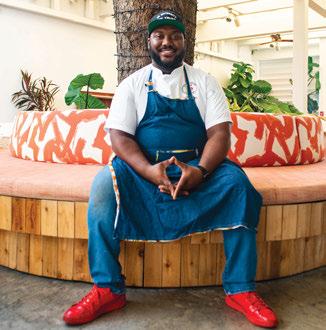
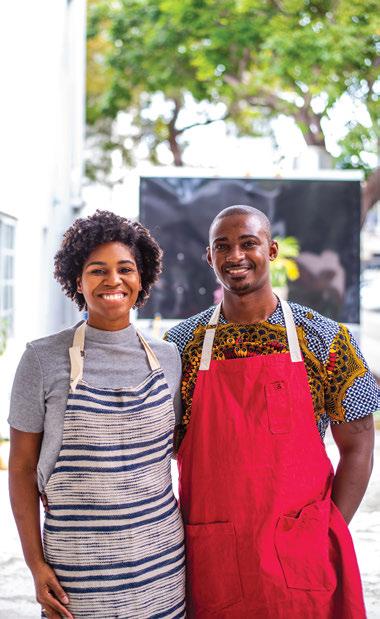
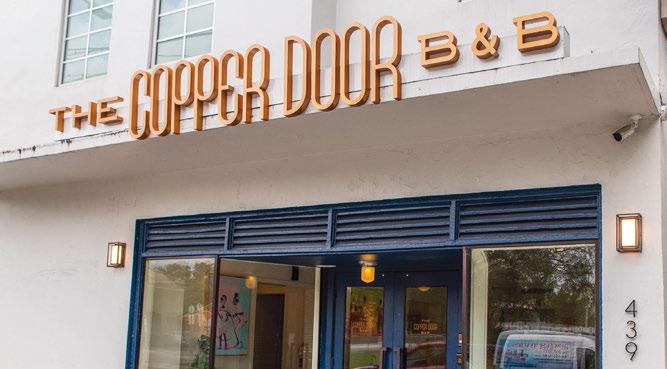


Clockwise from left: Jamila Ross and Akino West; e Copper Door B&B opened in 2018 after a restoration; Chef Tristen Epps' foie gras and plantain terrine; e Copper Door B&B stands on the site of the former Demetree Hotel. Opposite page, from top: A group of kids in Overtown during the Segregation Era; Chef Tristen Epps at Red Rooster Overtown.
Red Rooster is located on Northwest Second Avenue, known in its heyday as “Little Broadway,” “ e Strip,” and “ e Great Black Way,” as the area was a beacon for artists such as Sam Cooke, Billie Holiday, and Ella Fitzgerald. In hope of recreating the mix of performing arts locations and small businesses, the CRA created the Historic Overtown Culture and Entertainment District in 2019.
Epps rolled into Overtown as executive chef, ready to continue the legacy of the Marcus Samuelsson Group. But it’s a delicate dance to acknowledge the past while at the same time etch itself in the psyche of the Overtown of tomorrow.
Epps, who has a Trinidadian upbringing, hopes to connect to Miami through the food. He ate at holes-in-the-wall, sampled Latin and Afro-Caribbean food, then let those avors guide his menu. “From the moment I started writing the menu, I talked to other chefs to nd out, ‘What do I need to have?’” Epps says. He made the signature yard bird more citrus-forward, dumped the mashed potatoes for pigeon peas, added a raw bar and ceviches, and took inspiration from his international employees. “We tried to put all of that into the food to create a great, relatable menu with those small touches from Red Rooster Harlem,” Epps says. “We made this restaurant for this community.”
e Copper Door B&B opened in 2018 after a meticulous restoration. (Keeping as much of the historial nuances as possible, Ross and West found a liquor bottle from the 1920s and a bullet shell in a closet.) e hotel developed a steady business from millennials and cruise ship passengers from the nearby port. Now, it’s meeting the culinary demands of the neighborhood through a restaurant, Rosie’s Miami, where people can delight in hot chicken, biscuits, wa es, cheddar grits, and croissants.
But becoming a thread of the community means not assuming a one-size- ts-all approach to restoration. One of West’s mentors (and Rising Star Mentor Award winner), Michael Schwartz, was considered a pioneer when he opened Michael’s Genuine Food & Drink 14 years ago in the Design District, then an underdeveloped area of Miami about three miles from Overtown. But the Design District didn’t have the history and residences of Overtown, and today, the district’s streets are lined with posh designers such as Hermès, Cartier, and Louis Vuitton.
Both Red Rooster and Rosie’s Miami worked with World Central Kitchen to feed the neighborhood during the coronavirus and are committed to hiring Overtown residents. But West says that there’s a lack of quali ed resumes, so he and Ross hope to create an educational arm of their Independent Hospitality.
“When it comes to guests, we steer them to Overtown, Wynwood, Downtown, Little Havana, etc., as opposed to typical tourist locations,” Ross says. “We are advocates for cultural and historical Miami.”
Overtown Through the YearsOvertown Through the Years Through Years
1930s
e Central Negro District, later to be known as Overtown, is established due to segregation.
1956
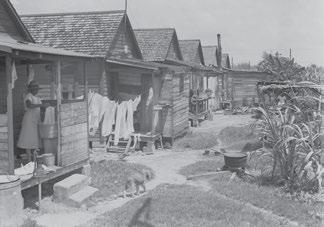
Overtown, 1940s
1937
Overtown has become overcrowded, and many white employers complain that their Black employees are bringing disease to their homes. Liberty Square public housing is built to relocate Black people outside of the city limits.
Interstate 95 plans are nalized. It reaches the southern end of the state in the 1960s and is built in the middle of Overtown, decimating homes and businesses. I-395 follows.

Children march for integrated schools, 1958
1964
With segregation abolished, residents have another reason to start migrating all over Miami-Dade County. e decline of Overtown continues.
1982 1950s
Overtown becomes the Miami center for Black prosperity, where arts and entertainment venues and other businesses thrived.

e Dorsey Memorial Library opened in 1941 and is named after Dana A. Dorsey, Miami's rst Black millionaire.
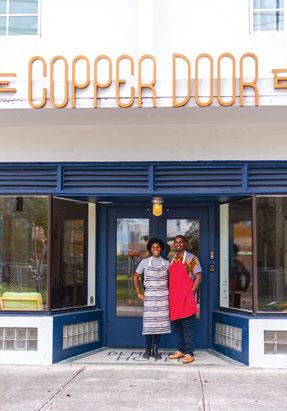
e Copper Door B&B, 2021
e Southeast Overtown/Park West Community Redevelopment Agency is founded.
2018
e Copper Door B&B opens, newly restored.
1989
e Lyric eater, constructed in 1913, is listed in the National Register of Historic Places. e restoration process continues today.
2019
e Historic Overtown Culture and Entertainment District plan is released.
2020
